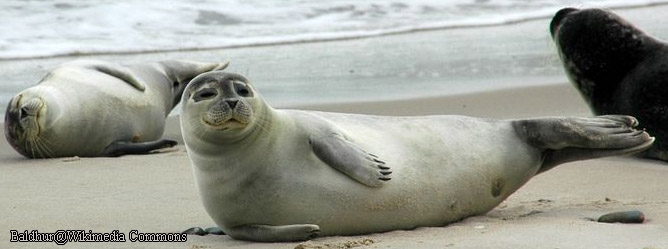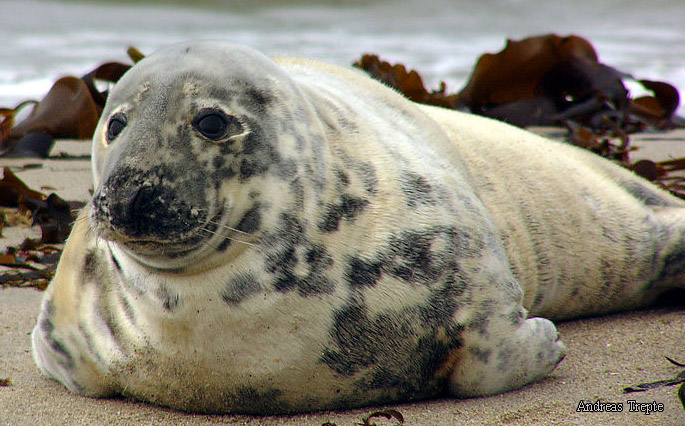Seals
| Icon(s) |  
|
| Harbor Seal | |
| Gray Seal | |
| Hooded Seal nasal display -- thesealofnam.org | |
| Harp Seal colony -- Wikimedia Commons | |
1. Types
1.1 Harbor Seal (Phoca vitulina)
Harbor seals are brown, tan, or gray, with distinctive V-shaped nostrils. An adult can attain a length of 1.85 meters (6.1 ft) and a mass of 132 kilograms (290 lb). Harbor seals stick to familiar resting spots or haulout sites, generally rocky areas (although ice, sand and mud may also be used) where they are protected from adverse weather conditions and predation, near a foraging area.
Harbor seals are gregarious animals, though they do not form groups as large as some other seals. When not actively feeding they will haul to rest. They tend to be coastal, not venturing more than 20 kilometers offshore.
1.2 Gray Seal (Halichoerus grypus)
t is a large seal, with bulls reaching 2.5–3.3 m (8.2–11 ft) long and weighing 170–310 kg (370–680 lb); the cows are much smaller, typically 1.6–2.0 m (5.2–6.6 ft) long and 100–190 kg (220–420 lb) in weight. Individuals from the western Atlantic are often much larger, males reaching 400 kg (880 lb) and females weighing up to 250 kg (550 lb). It is distinguished from the harbor seal by its straight head profile, nostrils set well apart, and fewer spots on its body. Bull Greys have larger noses and a less curved profile than common seal bulls. Males are generally darker than females, with lighter patches and often scarring around the neck. Females are silver grey to brown with dark patches.
During the winter months grey seals can be seen hauled out on rocks, islands, and shoals not far from shore, occasionally coming ashore to rest. In the spring recently weaned pups and yearlings occasionally strand on beaches after becoming separated from their group.
1.3 Northern Seals
Found only in the northernmost regions of 'Souls territories -- the Northumberland Strait is populated by these seals, along with the Ashes and Ashes coast.
Harp Seal (Pagophilus groenlandicus)
The harp seal has a cute face with silvery-gray body. Its eyes are pure black. It has black harp or wishbone-shaped markings on the back. Harp seals prefer to swim in the ocean, spending relatively little time on land. They are therefore difficult for landed Luperci to hunt and catch.
Hooded Seal (Cystophora cristata)
The generic name means "bladder-bearer" in Greek, from the peculiar inflatable bladder on the head of the adult male – this bladder hangs between his eyes and down over his upper lip in the deflated state.
2. Speech
According to our Speech Guide, this creature speaks High Speech naturally. It is therefore able to communicate with Luperci -- however, keep in mind that speech can be complicated by differences in vocal sounds (e.g., a Whale will sound much different from a Bear, even when both are speaking high speech).
3. Uses
Seals have been used for their pelts, their flesh, and their fat, which was often used as lamp fuel, lubricants, cooking oil, a constituent of soap, the liquid base for red ochre paint, and for processing materials such as leather and jute.
- Wikipedia:Seal_hunting
- Pelt: Seal skins have been used by aboriginal people for millennia to make waterproof jackets and boots, and seal fur to make fur coats.
- Meat
4. More
- Something
5. 'Souls
- Seals are one of the few species found in the burned areas of Ashes and Ashes.
- Seals are also found throughout 'Souls, such as in the harbor of Eastern Rise, as well as within Midnight Shores territory
- New Dawn had a big seal hunt in May 2014.[1]




